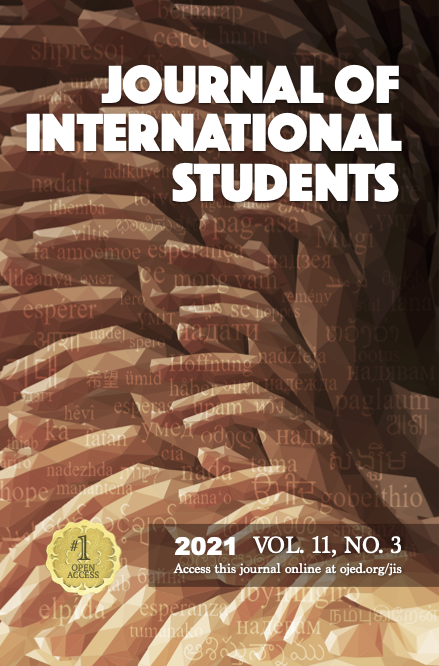Views on Learning Difficulties in Basic Sciences by Mainland Chinese Students
DOI:
https://doi.org/10.32674/jis.v11i3.2274Keywords:
basic/pure science, cultural background, early education, memorization, scientific English, self-directed learningAbstract
Science programs at Western higher education institutions are popular with mainland Chinese students. My teaching experience in Chinese classes suggests significant challenges for China-raised students in gaining deep appreciation and understanding of the principles of pure science, which differs from applied science in motivation and skills. The learning difficulties can be traced to students’ early education and cultural background. Science further communicates in a different style to other forms of English, adding complexity to writing and reading science texts. The information provided here could benefit future development of new course structures and teaching style in basic sciences, which is expected to generate a better appreciation of Western basic science philosophy by China-raised learners who in turn will gain a more rewarding learning experience.
References
Bone, E. K., & Reid, R. J. (2011). Prior learning in biology at high school does not predict performance in the first year at university. Higher Education Research & Development, 30(6), 709–724. http://dx.doi.org/10.1080/07294360.2010.539599
Chan, K. (2009). Scientific English: An essential guide to academic English for Chinese scientists. Tsinghua University Press.
Ching, Y., Renes, S. L., McMurrow, S., Simpson, J., & Strange, A. T. (2017). Challenges facing Chinese international students studying in the United States. Educational Research and Reviews, 12(8), 473–482. https://doi.org/10.5897/ERR2016.3106
Crawford, I., & Wang, Z. (2015). The impact of individual factors on the academic attainment of Chinese and UK students in higher education. Studies in Higher Education, 40(5), 902–920. https://doi.org/10.1080/03075079.2013.851182
Dello-Iacovo, B. (2009). Curriculum reform and ‘Quality Education’ in China: An overview. International Journal of Educational Development, 29, 241–249. https://doi.org/10.1016/j.ijedudev.2008.02.008
Deng, Y., Kelly, G. J., & Xiao, L. (2019). The development of Chinese undergraduate students’ competence of scientific writing in the context of an advanced organic chemistry experiment course. Chemistry Education Research and Practice, 20(1), 270–287. https://doi.org/10.1039/C8RP00171E
Department of Education and Training (2019). 2017 Section 4 All student load. Australian Government. https://docs.education.gov.au/node/51331
God, Y. T., & Zhang, H. (2019). Intercultural challenges, intracultural practices: How Chinese and Australian students understand and experience intercultural communication at an Australian university. Higher Education, 78(2), 305–322. https://doi.org/10.1007/s10734-018-0344-0
Henze, J., & Zhu, J. (2012). Current research on Chinese students studying abroad. Research in Comparative and International Education, 7(1), 90–104. https://doi.org/10.2304/rcie.2012.7.1.90
Holmes, P. (2004). Negotiating differences in learning and intercultural communication: Ethnic Chinese students in a New Zealand University. Business Communication Quarterly, 67, 294–307. https://doi.org/10.1177/1080569904268141
Jin, L., & Cortazzi, M. (2006). Changing practices in Chinese cultures of learning. Language, Culture and Curriculum, 19(1), 5–20. https://doi.org/10.1080/07908310608668751
Kaplan, R. (1966). Cultural thought patterns in intercultural education. Language Learning, 2, 15–27. https://doi.org/10.1111/j.1467-1770.1966.tb00804.x
Kember, D. (2016). Why do Chinese students out-perform those from the West? Do approaches to learning contribute to the explanation? Cogent Education, 3(1), 1–15. https://doi.org/10.1080/2331186x.2016.1248187
Leong, P. (2015). Coming to America: Assessing the patterns of acculturation, friendship, formation, and the academic experiences of international students at a US college. Journal of International Students, 5(4), 459–474. https://doi.org/10.32674/jis.v5i4.408
Li, D., Remedios, L., & Clarke, D. (2014). Chinese students’ groupwork practices and experiences in China. Higher Education, 68(2), 227–241. https://doi.org/10.1007/s10734-013-9704-y
Light, R. L., Xu, M., & Mossop, J. (1987). English proficiency and academic performance of international Students. Tesol Quarterly, 21(2), 251–261. https://doi.org/10.2307/3586734
Ma, C. C. E., & Rapee, R. M. (2015). Differences in mathematical performance, creativity potential, and need for cognitive closure between Chinese and Australian students. The Journal of Creative Behavior, 49(4), 295–310. https://doi.org/10.1002/jocb.67
Mann, C., Canny, B., Lindley, J., & Rajan, R. (2010). The influence of language family on academic performance in year 1 and 2 MBBS students. Medical Education, 44(8), 786–794. https://doi.org/10.1111/j.1365-2923.2010.03711.x
National Science Board (2018). Science and engineering indicators 2018. Higher education in science and engineering. National Science Foundation.
Niu, W., & Sternberg, R. J. (2003). Societal and school influences on student creativity: The case of China. Psychology in the Schools, 40(1), 103–114. https://doi.org/10.1002/pits.10072
O’Meara, S. (2019). The materials reality of China. Nature, 567, S1–S5. https://doi.org/10.1038/d41586-019-00885-5
Poole, A. (2016). ‘Complex teaching realities’ and ‘deep rooted cultural traditions’: Barriers to the implementation and internalisation of formative assessment in China. Cogent Education, 3(1), 1–14. https://doi.org/10.1080/2331186x.2016.1156242
Ren, J., & Hagedorn, L. S. (2012). International graduate students’ academic performance: What are the influencing factors? Journal of International Students, 2(2), 135–143. https://doi.org/10.32674/jis.v2i2.526
Rublik, N. (2018). Chinese cultural beliefs: Implications for the Chinese learner of English. Sino-US English Teaching, 15(4), 173–184. https://doi.org/10.17265/1539-8072/2018.04.001
Salili, F. (1996). Accepting personal responsibility for learning. In D. A. Watkins & J. B. Biggs (Eds.), The Chinese learner: Cultural, psychological and contextual influences (pp. 86–105). The Central Printing Press.
Valiente, C. (2008). Are students using the ‘wrong style’ of learning? A multicultural scrutiny for helping teachers to appreciate differences. Active Learning in Higher Education, 9(1), 73–91. https://doi.org/10.1177/1469787407086746
Wan, Z. H., Wong, S. L., & Yung, B. H. W. (2011). Common interest, common visions? Chinese science teacher educators’ views about the values of teaching nature of science to prospective science teachers. Science Education, 95(6), 1101–1123. https://doi.org/10.1002/sce.20451
Wang, C. C., Andre, K., & Greenwood, K. M. (2015). Chinese students studying at Australian universities with specific reference to nursing students: A narrative literature review. Nurse Education Today, 35(4), 609–619. https://doi.org/10.1016/j.nedt.2014.12.005
Xing, M., Wang, J., & Spencer, K. (2008). Raising students’ awareness of cross-cultural contrastive rhetoric via an e-learning course. Language Learning & Technology, 12(2), 71–93. http://dx.doi.org/10125/44144
Downloads
Published
Issue
Section
License
Copyright (c) 2021 Journal of International Students

This work is licensed under a Creative Commons Attribution-NonCommercial-NoDerivatives 4.0 International License.
All published articles are licensed under a Creative Commons Attribution-NonCommercial-NoDerivs 4.0 Unported License.













